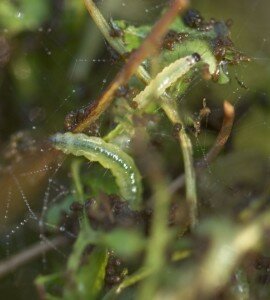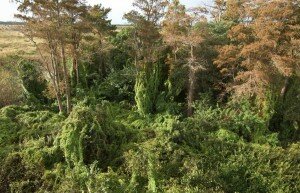SFWMD, USDA agree on operation of “Bug Nursery” in Davie

Caterpillars of the brown lygodium moth (left) feed on invasive Old World climbing fern (Lygodium microphyllum), which can completely cover and shade out native plants.
The South Florida Water Management District (SFWMD) Governing Board today approved a cooperative agreement with the U.S. Department of Agriculture’s Agricultural Research Service (USDA-ARS) to operate and manage a science facility to raise insects for use as biological controls. These insects will be used to control the spread of invasive exotic plant species, such as melaleuca, Lygodium and Brazilian pepper.
The District and the U.S. Army Corps of Engineers signed a separate Project Partnership Agreement in July for cost sharing the construction and operation of this facility, a 2,700-square-foot annex to the USDA-ARS’s Invasive Plant Research Laboratory in Davie.
“This facility will be a collaborative, science-based effort by several state and federal agencies to slow the spread of exotic plant species that are harming South Florida’s ecosystems,” said SFWMD Governing Board Chairman Eric Buermann. “Partnerships on projects such as this one are crucial to furthering the progress we must make together to restore America’s Everglades.”
Under the new cooperative agreement, the District will contribute $2.65 million over five years to USDA-ARS to raise and release the biological control insects and monitor them in the field as part of an integrated pest management strategy.
The agreement includes a series of renewal options that cover operations and maintenance of the facility for up to 24 years. For the next several decades, the annex will be raising colonies of insects to help protect South Florida’s ecosystems and the Everglades, including:
- Several types of midges and weevils to fight melaleuca
- Moths, mites and stem borers that target Lygodium, also known as Old World climbing fern
- Sawflies, thrips and weevils for control of Brazilian pepper
Prior to raising insects and other biological controls in this new facility, the USDA-ARS will complete an exhaustive quarantine

Cypress Creek-Loxahatchee property West of I-95 cypress tress and Lygodium invasive exotic
testing program to demonstrate that the insects are safe and only target specific exotic plants.
The Florida Department of Environmental Protection (DEP), in cooperation with the District, USDA and the University of Florida, has facilitated the agreements necessary to ensure that the project on state-owned land can proceed as scheduled. Construction of the facility is scheduled to be completed by the Corps in early 2012 using an investment of $1.6 million in federal funding under the American Recovery and Reinvestment Act of 2009.
“Invasive plant species are every bit as damaging to South Florida’s ecosystems as exotic Burmese pythons, which have drawn so much attention from the public,” said Ken Ammon, P.E., SFWMD Deputy Executive Director – Everglades Restoration and Capital Projects. “The biological controls that will be developed at this facility will provide an environmentally friendly defense against invasive plants, supporting our efforts to protect and restore the Everglades.”
Background: The Invaders
Non-native plants stress the natural environment by crowding out native vegetation, which a diverse array of wildlife depend on for food and habitat. Invasive plants can also clog flood control canals and structures, impede waterway navigation and impact recreation and other facets of the Florida economy.
Since first making its way to Florida in the late 1960s, Old World climbing fern (Lygodium microphyllum) and Japanese climbing fern (L. japonicum) have become two of the most invasive exotic plants in the state. These climbing ferns grow quickly in South Florida without the natural pests and regulatory factors that keep them in check in their native areas of Australia and Asia. The ferns cover and shade out native plants, eventually killing them.
Brazilian pepper (Schinus terebinthifolius) is a South American shrub first introduced into Florida as an ornamental plant in the 19th century. Today, it is considered one of the most noxious, widespread weeds in the state, infesting almost 1 million acres in South Florida alone. The peppers readily invade everything from fallow farmland to hardwood hammocks and mangrove forests.
SFWMD Invests in Biocontrols and Science
The new rearing facility is the latest investment in biological controls by the District. The agency has devoted approximately $20 million in each of the past five years to remove the most threatening invasive species, such as melaleuca, Old World climbing fern, Brazilian pepper and water hyacinth. In Fiscal Year 2009 alone, the District treated approximately 94,000 acres to combat melaleuca, torpedo grass, the climbing fern and other offenders.
One of the most visual efforts to control exotic plants inched through Jonathan Dickinson State Park in Martin County. The SFWMD, in partnership with the USDA Agricultural Research Service, released a thousand Neomusotima conspurcatalis moths at the park in 2008. The moths lay eggs that morph into caterpillars that chew through dense stands of the invasive Old World climbing fern without harming native Florida ferns.
Melaleuca remains an example of the District’s success in managing exotics.
Once covering hundreds of thousands of acres, this species now is only occasionally spotted on District-managed lands. What seemed to be an insurmountable invasive species now is being successfully managed through sustained interagency commitment.
Biological controls are an important part of this success. The combined effect of three established insect species is putting significant pressure on melaleuca’s ability to dominate Florida’s native plant communities.
The District-led melaleuca management program is nearly two decades old, and resource management agencies estimate this program has cost approximately $40 million to date. Florida’s melaleuca management program is a model for invasive species management nationally.
Continued Vigilance
The SFWMD supports continued applied scientific research that improves management efforts. To further facilitate that effort, the District participates in key partnerships with agencies, including: the Florida Fish and Wildlife Conservation Commission (FWC); the Florida Department of Environmental Protection; the U.S. Fish and Wildlife Service; the USDA’s Agricultural Research Service; the U.S. Army Corps of Engineers and the U.S. Department of the Interior.
Residents also play an important role in the protection of South Florida’s environment. One of the primary ways invasive species, both plant and animal, end up in the natural environment is by being thrown out or released by people who no longer want them. For example, emptying a tropical aquarium full of live but non-native aquatic plants can have serious consequences for the environment.
For more information on invasive plants, visit www.sfwmd.gov.
Related posts:
- SFWMD testifies in Washington on legislation banning non-native pythons
- Water management district testifies support for banning imported pythons
- SFWMD Highlights a Year of Significant Restoration Progress
- SFWMD, Partners Work to Protect Loxahatchee River and Estuary
- SFWMD, Hallandale Beach Partner to Improve Water Quality
Short URL: https://browardnetonline.com/?p=10108



